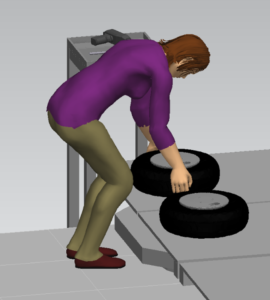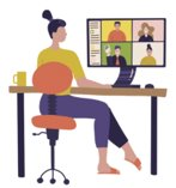
Ergonomics in the workplace has become the norm with the advancement of health and safety policies, standards, and guidelines aimed at preventing and mitigating ergonomic risk to workers. Employers seek to educate their employees on ergonomic literacy and use in-house or external professionals to develop and implement workplace ergonomic programs.
As adults in the ‘world of work’ benefit from this wave of acceptance and understanding of the importance of ergonomics, what are children experiencing? Are these same systems and practices applied at home and in school?
A review of academic research and literature unveils a stark contrast in how our children’s musculoskeletal health has not yet gained focus with applied ergonomics as part of everyday life. Researchers acknowledge that ergonomics is important for children’s health and that application of this occupational health practice for children has not been applied in any significant way.
Today, more than ever, “screen media” devices are being used by children than in past years. Whether they are doing homework, playing games, watching videos or chatting with their friends, children are using these devices considerably more than in previous years. As with adults, static uses of devices is a source of risk and injury and the importance of ergonomics when using these devices is often neglected or not thought of until it is too late.
Jawad Fares et al (2017) studied musculoskeletal neck pain in children and adolescents, and found that of the children and youth in the study, 100% of them were experiencing neck pain, 69% shoulder pain, 61% low back pain and 13% had pain in their arms. These children were asked to demonstrate how they used their mobile devices, and all showed strong flexion of the neck (greater than or equal to 45 degrees). It is evident that children are using these devices frequently and often without the proper education on proper use in order to minimize risks.
Why are children at risk?
- Children’s use of devises is increasing
A Census Report of children ages 0 to 8 indicated that in 2011, 52% of those surveyed had some form of mobile device in the home. In 2017 that number increased to 98%. These devices are used for many things – learning, communication, entertainment, games etc. (The Common Sense Census, 2017). - Children are using devices improperly
Children are using these devices without proper set up in mind at school and at home, resulting in awkward static postures which can lead to musculoskeletal discomfort and potential injury. - Young bodies are still growing and changing
“Young Children and Screen Time” in the Journal of Developmental and Behavioral Pediatrics indicates that it is not just the postural risks that children are exposed to with prolonged screen time. The lack of whole-body movement results in a lower energy expenditure which increases risks of obesity. Additionally, overall reduction in movement can result in overall lower peak bone and muscle mass which could result in lower gross motor skills (Straker et al, 2016).
How can we help children avoid pain/discomfort and potential injury?
1. Help your child to achieve proper postures when working on a laptop, tablet or desktop at home. Start by creating a dedicated workspace that your child can go to and educate them on proper set up and posture so that it becomes natural and habitual for them.
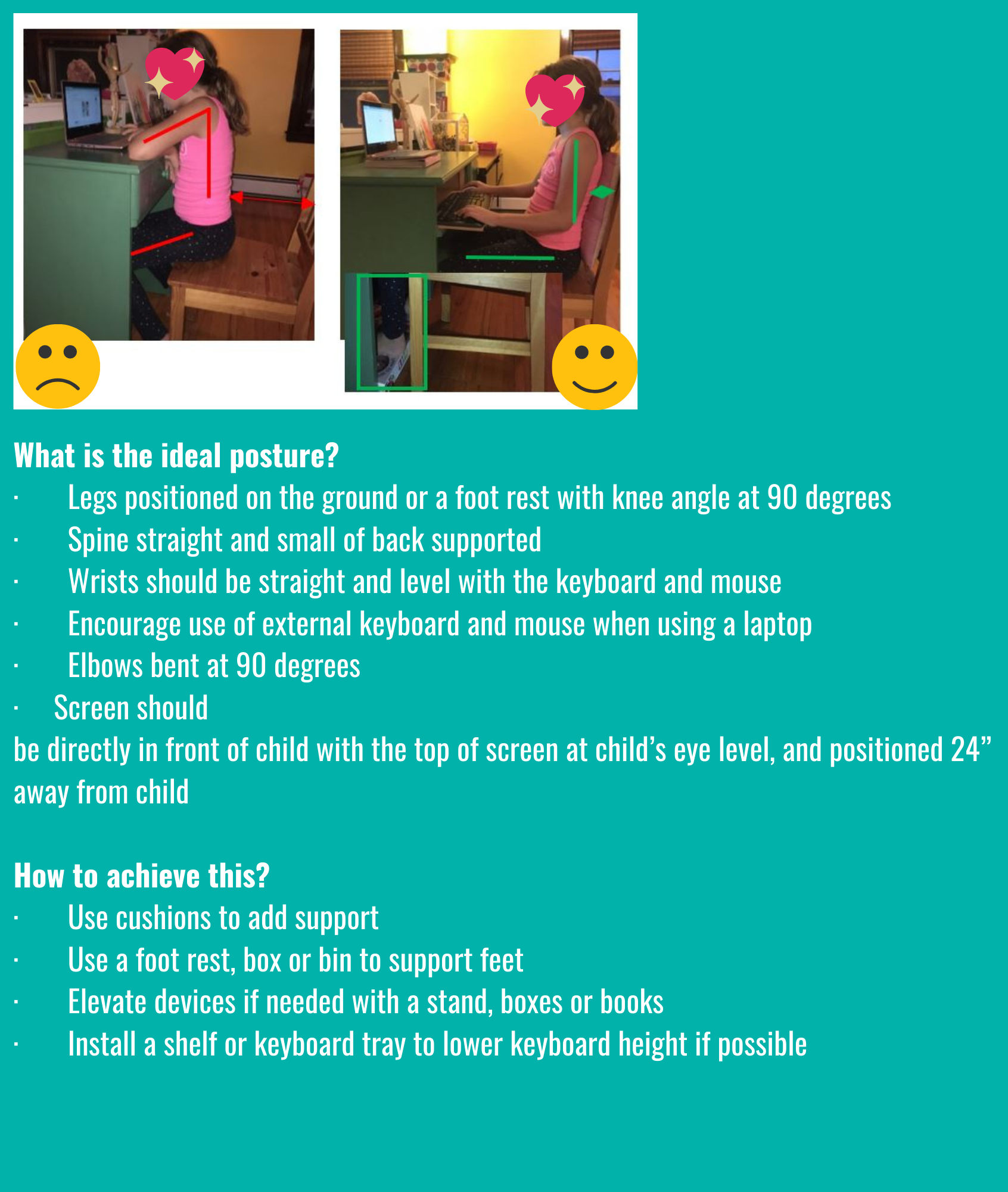
2. Provide your child with tools to help their set up at school. Many schools today provide laptops or tablets as a learning tool. Children and teachers may not be aware of proper positioning and tools that may help reduce discomfort and or injury.
3. Encourage and educate proper posture even during play. Children can spend long periods of time playing with held devices. These types of devices often put children in an awkward posture at home or on the go.
4. Consider purchasing equipment made for children.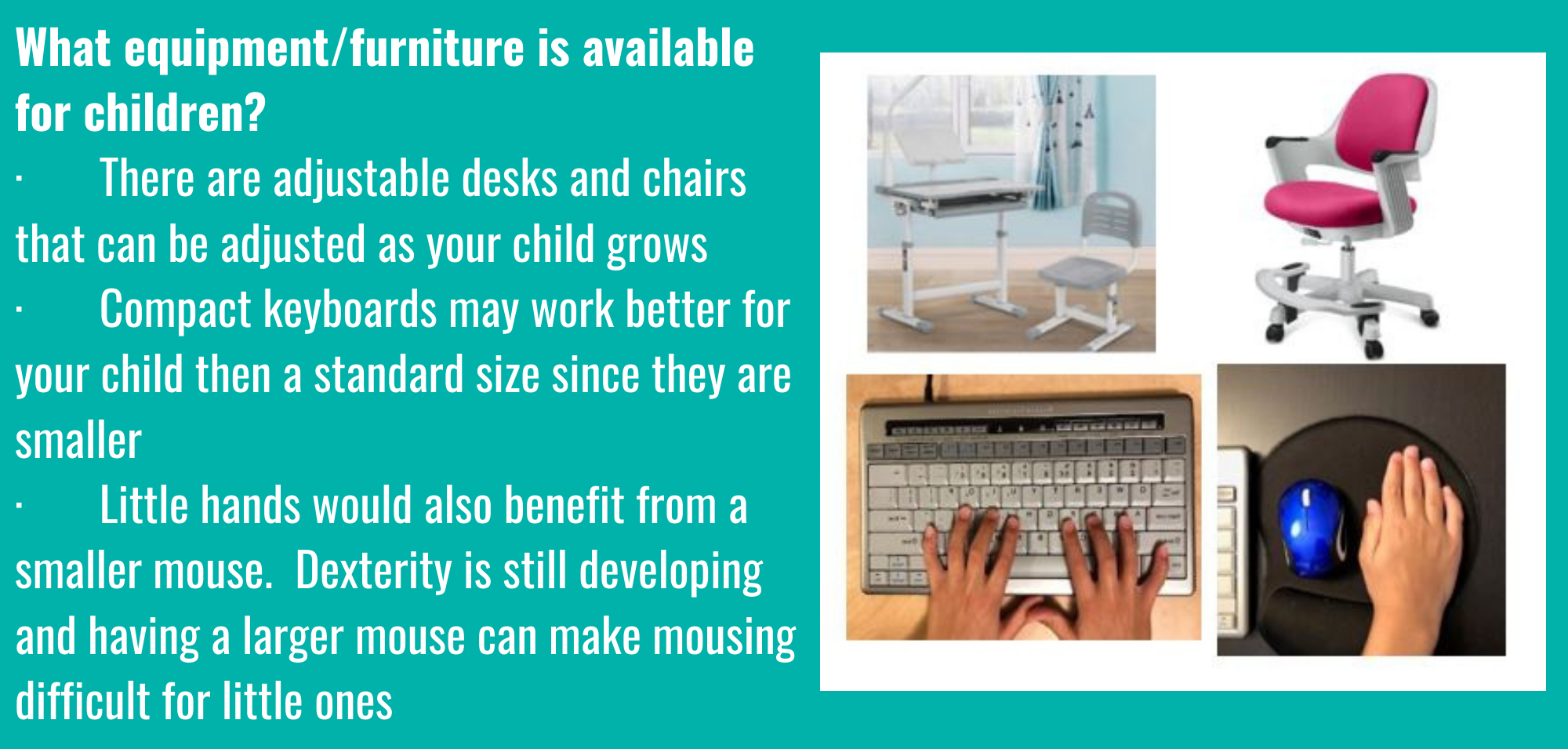
5. Other things to consider.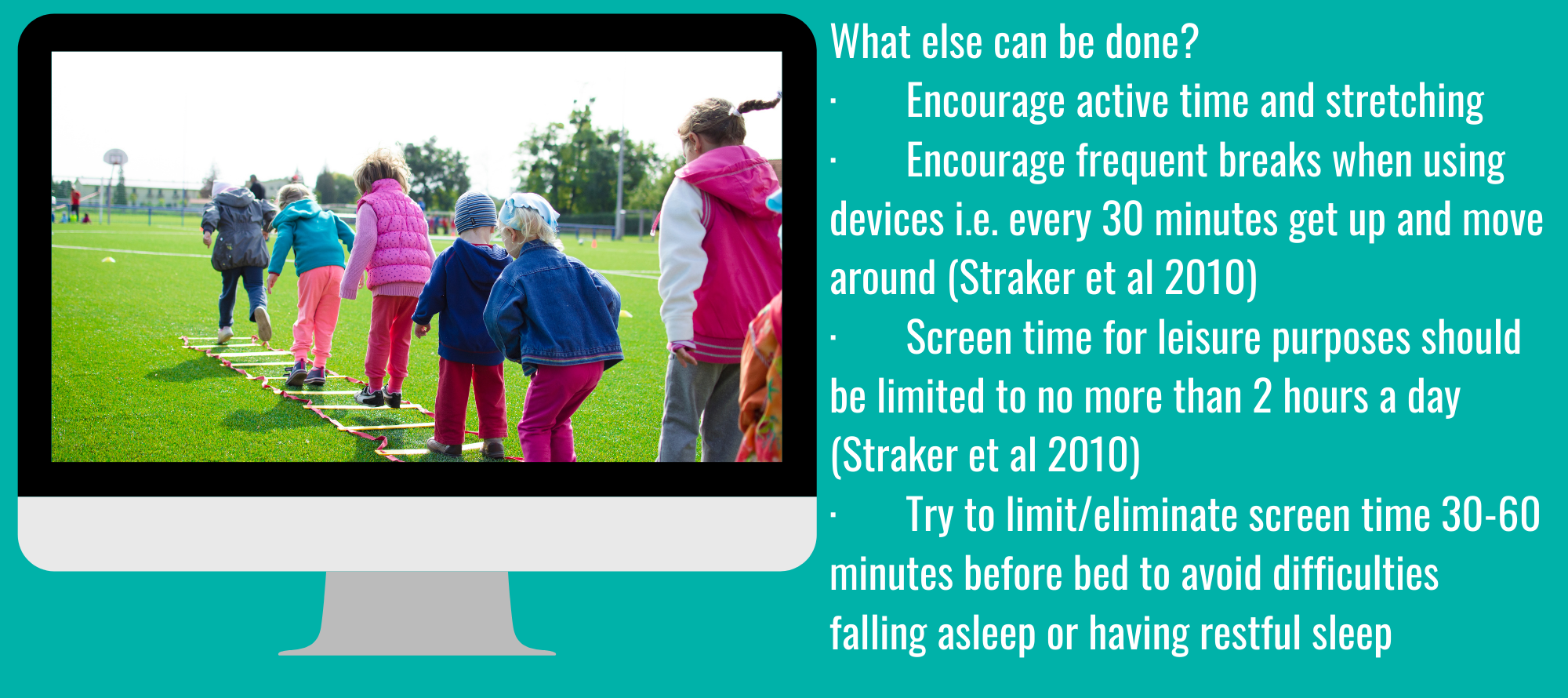
References
Straker, C. Harris, J. Joosten & E. Howie (2017). Mobile technology dominates school children’s IT use in an advantaged school community and is associated with musculoskeletal and visual symptoms. Ergonomics, 61:5, 658-669.https://dl.uswr.ac.ir/bitstream/Hannan/50957/1/2018%20Ergonomics%20Volume%2061%20Issue%205%20May%20%2810%29.pdf
J. Fares, M. Fares & Y. Fares (2017). Musculoskeletal neck pain in children and adolescents: Risk factors and complications. Surgical Neurology International; May 10, 2017; 8:72 https://www.ncbi.nlm.nih.gov/pmc/articles/PMC5445652/
L. Straker, B. Maslen, R. Burgess-Limerick, P. Johnson and J. Dennerlein (2010). Evidence-based guidelines for the wise use of computers by children: Physical development guidelines, Ergonomics, 53:4, 458-477. https://www.researchgate.net/publication/42390717_Evidence-based_guidelines_for_the_wise_use_of_computers_by_children_Physical_development_guidelines
2017 Common Sense Census: Media Use by Kids age Zero to Eight https://www.commonsensemedia.org/sites/default/files/uploads/research/csm_zerotoeight_fullreport_release_2.pdf
L. Straker, E. Howie (2016). Young Children and Screen Time It is Time to Consider Healthy; Bodies as Well as Healthy Minds. Journal of Developmental and Behavioral Pediatrics, 37:3, p 265. https://journals.lww.com/jrnldbp/Citation/2016/04000/Young_Children_and_Screen_Time__It_is_Time_to.17.aspx








 Why Sandalwood?
Why Sandalwood?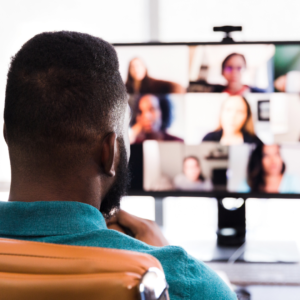


 We are a one-stop-shop for launching job rotation for any employer from conception to implementation. Our experts tailor our services to meet the needs of our customers by collaborating with them throughout the entire process. We do not offer cookie cutter solutions for job rotation because the needs of employers vary significantly.
We are a one-stop-shop for launching job rotation for any employer from conception to implementation. Our experts tailor our services to meet the needs of our customers by collaborating with them throughout the entire process. We do not offer cookie cutter solutions for job rotation because the needs of employers vary significantly. Why Sandalwood?
Why Sandalwood?



 Sandalwood is pleased to offer solutions above and beyond the traditional ergonomic assessments. With an in-depth knowledge of various digital human modelling software suites, integration and adoption to your health and safety programs has never been easier. Sandalwood is experienced in ergonomic program design as well as industry leaders in digital human modelling services. We have a diverse team that is able the leverage the results from the digital human model to provide in depth risk assessments of future designs and current state. Sandalwood is also able to pair these assessments with expertise and provide guidance on the best solution for you. Sandalwood is also on the forefront of emerging technologies and able to integrate Motion capture, Wearables, and extended or virtual reality into your ergonomic program.
Sandalwood is pleased to offer solutions above and beyond the traditional ergonomic assessments. With an in-depth knowledge of various digital human modelling software suites, integration and adoption to your health and safety programs has never been easier. Sandalwood is experienced in ergonomic program design as well as industry leaders in digital human modelling services. We have a diverse team that is able the leverage the results from the digital human model to provide in depth risk assessments of future designs and current state. Sandalwood is also able to pair these assessments with expertise and provide guidance on the best solution for you. Sandalwood is also on the forefront of emerging technologies and able to integrate Motion capture, Wearables, and extended or virtual reality into your ergonomic program.
